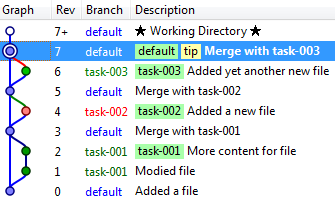Posted by Mark Withall: 2014-03-22
Some thoughts on the relative merits of rebasing a branch before merging when working with a DVCS like Mercurial or Git.
Updated 18th April 2014 with some comments from my colleague @DaveCTurner
Merge

Pros
- Simple to perform
- Maintains the original context of the source branch
- Easy to find points where merge conflict resolution failed
Cons
- Can’t bisect to find cause of bugs (requires linear history)
- Non-linear histories mean that working and non-working versions can be interleaved making it unlikely that bisect will end up at the revision that caused the bug
- Difficult to read the history
- Further con of merging is that conflict resolution is atomic. If you have a knarly merge then doing it in pieces is better. I claim that resolving conflicting patches in the queue is much easier than 3-way merging @DaveCTurner
- You can do topological bisection in a mergy history, but the chances are the first bad commit is the merge, which doesn’t help you with debugging. @DaveCTurner
Rebase

Rebase means different things to different people. Let me start by clarifying what I mean. This is best done with a picture (see above). When I say rebase, I mean moving the whole branch to the top of the tree without moving all changesets onto the default branch or flattening into a single changeset (two common alternative meanings, particularly in the Git world). This means that we lose the minimum of information.
Pros
- Can easily track down cause of bugs using bisect
- Simple to read history with clearly defined tasks
Cons
- Hard to find where merge conflict resolution failed
- But can partly be done by reordering the changesets by time
- Or better, if there is a conflict, rebase using the patch queue and name the commits that resolve conflicts explicitly
- This is less of an issue if you have good test coverage
- Can only be done with local changesets (i.e. before pull or push); hence can prevent collaboration on a branch
- You can collaborate on a branch when rebasing, either with bundles or a private clone set up for just the branch. Requires about the same amount of coordination as the alternatives. @DaveCTurner
Personally, I tend to favour the rebase approach as I’m somewhat OCD about having a pretty looking graph of the history.
Tweet Follow @MarkWithall